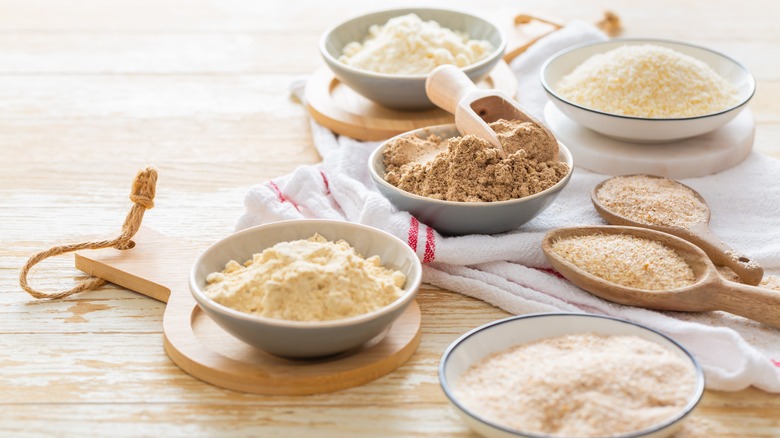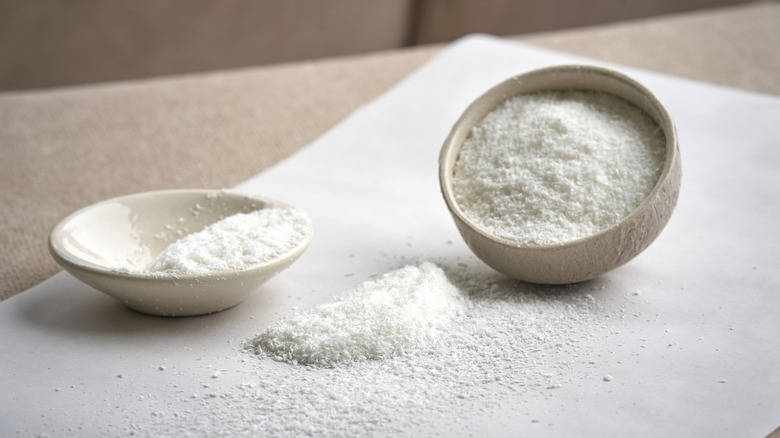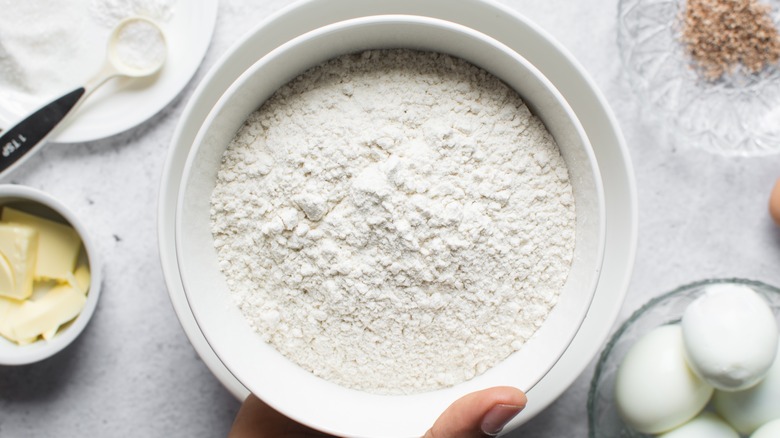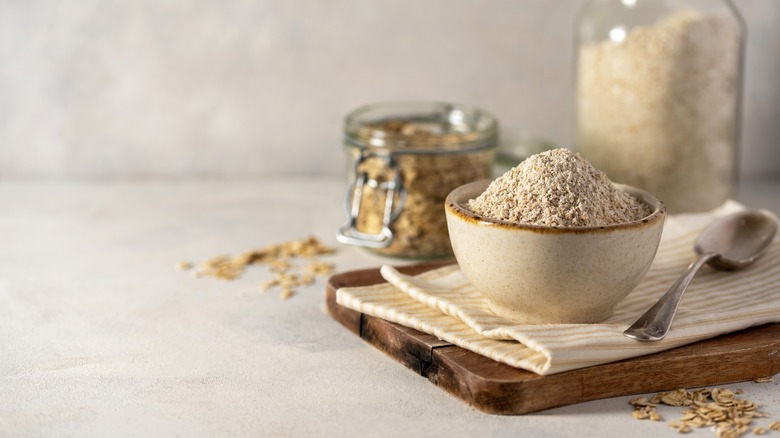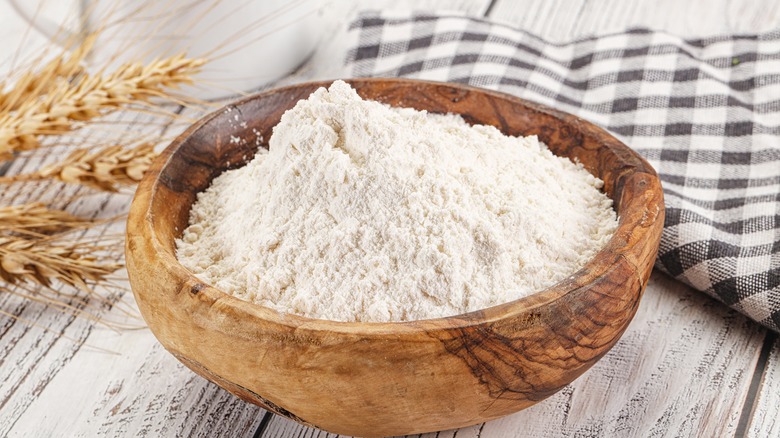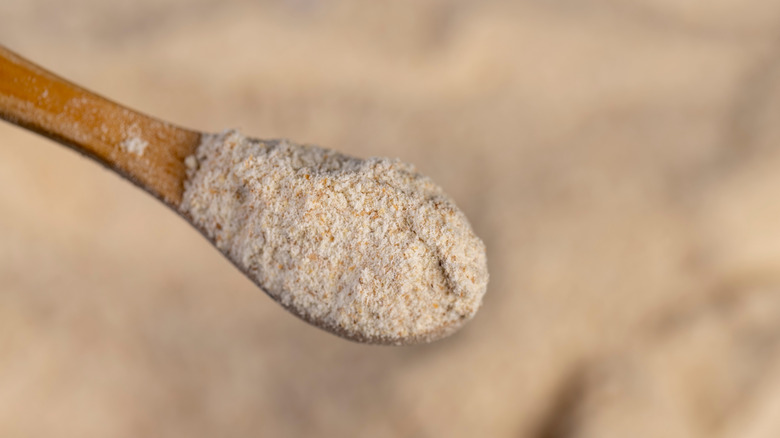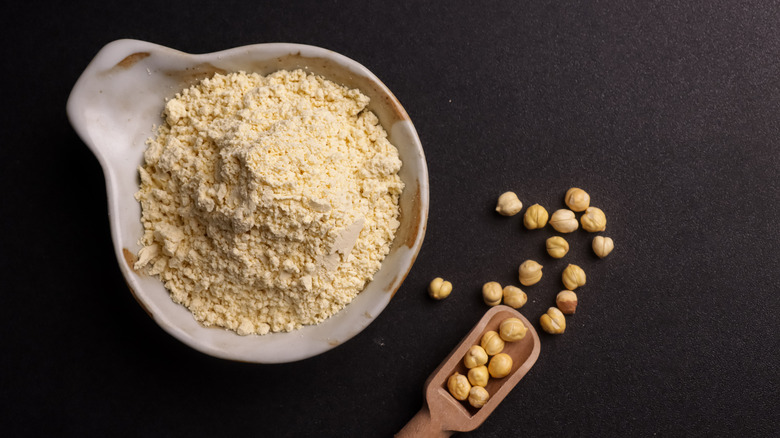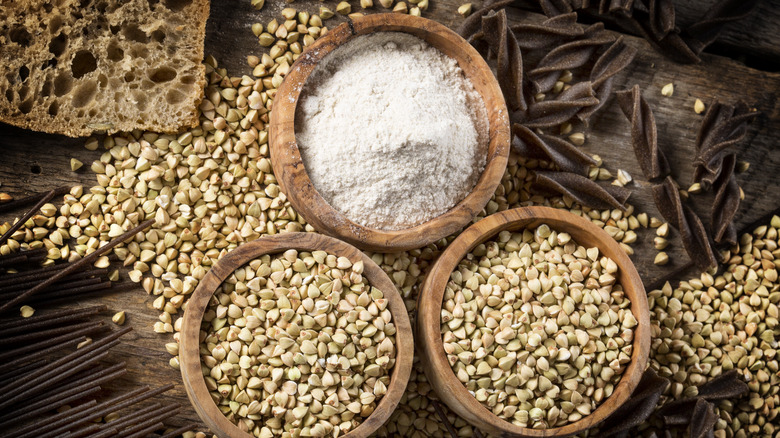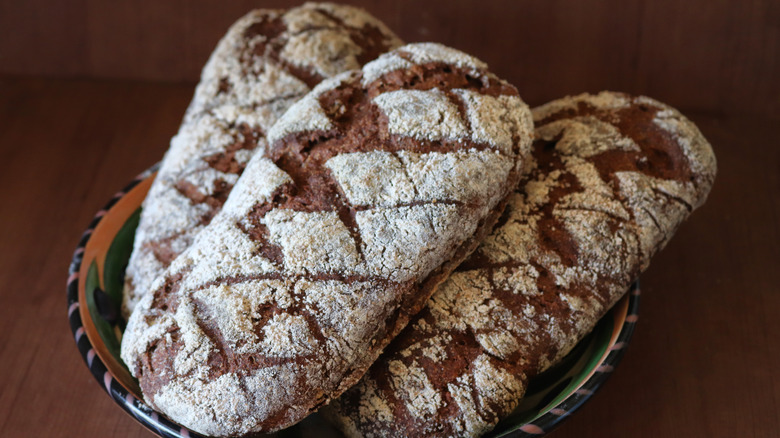Experts Reveal The 7 Healthiest And 4 Unhealthiest Flours
We may receive a commission on purchases made from links.
Whether it's your fluffy homemade pancakes, the tortilla for your burrito, or even your fried chicken, flour might be the most ubiquitous ingredient in our diet. But, unfortunately, not all flours are created equal, and the type you choose can make a big difference to your health. Some flours come packed with protein, fiber, healthy fats, and an impressive array of vitamins and minerals. Others have been stripped bare of their natural goodness, leaving little more than simple carbohydrates that can send your blood sugar on a rollercoaster ride and leave you feeling hungry again soon after.
The good news? We've never had more flour options to choose from than we do today. Beyond the familiar white and whole wheat, store shelves now offer everything from ancient grain varieties and protein rich nut flours to specialized gluten-free options.
To help sort through these options, we've brought in two experts who know their flour. Barbara Zeiss brings practical expertise as the founder and baker behind Plantiful Kitchen, a specialty bakery in Carlsbad, California. Her bakery specializes in creating delicious treats that are 100% plant-based, gluten-free, grain-free, and free from refined sugars — proving that nutritious alternatives can still deliver on flavor. Jackie Newgent, RDN, CDN, brings nutritional expertise as both a plant-forward culinary nutritionist and professional chef based in Los Angeles. As the author of "The Plant-Based Diabetes Cookbook," she offers valuable insights on how different flours affect our health.
Healthiest: Almond flour
"My absolute favorite flour to work with is almond flour. We use it in all our baked goods at Plantiful Kitchen. I love the flavor, how sweet and nutty it is," shares Barbara Weiss. Not only does it have a great taste, but it also has impressive nutritional benefits. It's packed with protein, healthy fats and vitamins. Weiss explains that, "almonds are also high in prebiotic fiber which is great for the health of your microbiome."
The numbers back up these claims. Just 1 ounce (28 grams) of almond flour contains 14.2 grams of fat (9 of which are heart-healthy monounsaturated fats), 6.1 grams of protein, and 35% of your recommended daily intake of vitamin E. It's also rich in essential minerals including manganese, magnesium, copper, and phosphorus. Almond flour is also great for people managing diabetes or blood sugar issues. Its lower carbohydrate content (5.6 grams per ounce) makes it an excellent option alongside other nut flours.
Unhealthiest: White flour
Jackie Newgent explains that refined white flour undergoes a processing method that fundamentally alters its nutritional profile. "It's actually a wheat flour that, during processing, is basically stripped of its healthiest parts, the bran and germ. What remains is the starchy component that's lacking in nutrient density, including fiber."
This refining process causes it to loose substantial nutrients. When whole grains are processed into refined flours, not only do they lose most of their naturally-occurring fiber, but also significant amounts of B vitamins, minerals like iron and zinc, and health-protective phytonutrients. While some manufacturers attempt to address these deficiencies through enrichment, Newgent notes that this provides only a partial solution. "When refined "white" flour is enriched, some B vitamins and iron are added back, for instance, but it doesn't reach the original nutrient levels, and it's still lacking in fiber." Newgent estimates that, "whole grain flours offer about three times the vitamins, minerals, fiber, and other health-promoting compounds as their refined counterparts."
Regular consumption of refined flour products may lead to several potential health concerns. Without significant fiber, foods made with these flours can cause blood sugar spikes after meals. Additionally, some white flours may contribute to inflammation, negatively impact gut health, and provide less satiety than their whole-grain counterparts.
It's important to note that all flour undergoes some processing simply through grinding. However, it's the highly refined varieties found in ultra-processed foods that raise the most significant health concerns, particularly when consumed regularly and in large quantities.
Healthiest: Coconut flour
Coconut flour ranks high on Barbara Zeiss's list of favorite flours, and it's easy to see why when we look at its nutritional profile. A 1 ounce serving of coconut flour contains 18 grams of carbohydrates, an impressive 10 grams of fiber, and 6 grams of protein. It also provides 11% of your daily iron needs and 13% of your daily potassium requirements. When compared to traditional wheat flour, coconut flour delivers significantly more fiber, protein, and essential minerals.
The fiber content particularly stands out. "Fiber is like the fuel for our gut microbiome and we should always make sure to eat adequate amounts of it since gut health plays such an important role in our overall health," Zeiss explains. She specifically notes that, "Coconut flour has mostly insoluble fiber which feeds the beneficial bacteria in your gut." Insoluble fiber helps regulate bowl movements and relieve constipation.
This high fiber content does more than just support gut health. Foods rich in fiber help regulate blood sugar levels by slowing down how quickly sugar enters your bloodstream. Since coconut flour contains more fiber and protein while having fewer carbohydrates than all-purpose flour, it can be particularly helpful for blood sugar management.
Unhealthiest: Bleached flour
Bleached flour takes refined white flour a step further by adding chemical processing specifically designed to whiten the flour and artificially accelerate the natural aging process. This additional processing introduces substances that both experts consider problematic for health.
"Bleached flour has been treated with chemical agents, such as benzoyl peroxide, potassium bromate, or chlorine," Barbara Zeiss explains. "These, in my opinion, are very concerning ingredients and also unnecessary. I would stay away from them." Jackie Newgent agrees, noting that the chemical processing "may negatively impact the flour's protein content as well as irritate the gut."
The potential health concerns associated with these bleaching agents are significant. Zeiss points out that benzoyl peroxide has been linked to gut irritation and allergic responses in sensitive individuals and is banned in Europe. Potassium bromate presents even more serious concerns. "It's banned in 60 countries, but is still used in the USA. It's classified as a possible carcinogen and, in animal studies, has caused kidney tumors, thyroid issues, and other cancers," she warns. Chlorine, another common bleaching agent, "possibly causes diabetes and microbiome disruption, and is also banned for food processing in Europe."
Healthiest: Oat flour
Looking for a nutritious whole grain alternative to refined white flour? Oat flour deserves a spot in your pantry rotation according to our nutrition experts and it can even be made at home. This whole grain option provides impressive health benefits while maintaining the naturally sweet, mild, flavor of oats. What makes it special? For starters, oat flour contains beta-glucan, a specific type of soluble fiber that offers potential heart health benefits. With 3 grams of fiber per 1 ounce serving and 13% of your recommended daily iron intake, it delivers substantial nutrition.
The fiber content is particularly valuable as Jackie Newgent notes it's "a prebiotic that feeds "good" gut bacteria while helping to boost satiety, slow down the rate of digestion, and curb blood sugar spikes." The soluble fiber in oats works differently in your body than insoluble fiber found in some other flours. Newgent explains that "soluble fiber can help manage blood cholesterol and blood glucose levels," making it particularly valuable for heart health. This contrasts with insoluble fiber found in wheat, which is beneficial for digestive health. Both types are important, but they serve different functions in your body.
For optimal nutrition, Newgent suggests choosing flours with at least 3 grams of total fiber per serving. If you're new to incorporating high fiber flours like oat flour into your diet, Barbara Zeiss offers a practical tip — increase the amount slowly to avoid gas and discomfort. Your digestive system sometimes needs time to adjust to higher fiber intake.
Unhealthiest: Self-rising flour
Self-rising flour offers a lot of convenience by combining refined white flour with salt and leavening agents like baking powder. This all-in-one product simplifies recipes by eliminating the need to measure these ingredients separately, but this convenience comes with nutritional drawbacks. Jackie Newgent points out a specific concern with self-rising flour, noting that it "contains added salt and leavening agents, which may add unnecessary sodium to the diet." This additional sodium can be particularly problematic for those watching their salt intake for heart health or blood pressure management. If added salt is a concern for you, you could try making your own self-rising flour at home so you can control the amount of salt added.
While the convenience factor might seem appealing, the underlying refined flour base creates the same health concerns as regular white flour. Self-rising flour shares the blood sugar issues associated with refined flours. Barbara Zeiss explains that its high carbohydrate content and easy digestibility can "cause blood sugar rollercoasters." After consumption, "blood sugar will rapidly rise, but then crash a little while later," potentially leading to a cascade of uncomfortable symptoms.
These blood sugar fluctuations can manifest as tiredness after meals, irritability when skipping food, brain fog, strong carb cravings, mood swings, and afternoon energy crashes. The cycle can be particularly disruptive to energy levels and focus throughout the day. Over time, this pattern of blood sugar spikes and crashes may contribute to insulin resistance and other chronic health issues if refined flours make up a significant portion of your diet.
Healthiest: Whole wheat flour
"I love any whole grain flours, like whole wheat, which keeps all the grain whole — giving you satisfying fiber, protein, B vitamins, and minerals," Jackie Newgent shares. Nutritionally, whole wheat flour provides approximately 3 grams of fiber per 1 ounce serving. And as a non-ultra-processed food, it retains all its naturally-occurring nutrients rather than having beneficial components stripped away during processing.
It also contains abundant insoluble fiber concentrated in the bran portion of the wheat kernel which aids your digestive system. Components of wheat bran may also function as prebiotics, providing nourishment for beneficial bacteria in your gut. Additionally, much of the bran passes through your digestive system relatively unchanged, adding beneficial bulk to stool and supporting digestive transit.
Studies have linked consumption of whole grains, including whole wheat, to a reduced risk of colon cancer, one of the most common forms of cancer worldwide. One study, per Pub Med, estimated that people following low-fiber diets might cut their colon cancer risk by as much as 40% by increasing fiber intake. For those concerned about baking performance, Newgent offers a practical tip, "For baking, whole-wheat pastry flour is my go-to choice — use it 1-to-1 in place of all-purpose "white" flour."
Unhealthiest: Gluten flours (for some)
People with Celiac disease and gluten intolerance have to avoid gluten, but even those without diagnosed conditions may experience adverse effects from gluten. Barbara Zeiss explains that, "Gluten can be problematic even for individuals who don't have a known allergy or sensitivity to gluten because so many people already have damaged gut linings and inflammation in their bodies." This can potentially "increase gut permeability and lead to increased inflammation, brain fog, bloating, and fatigue."
According to Zeiss, the list of gluten-containing grains is more extensive than many realize. These include "wheat with all its derivatives such as whole wheat, durum, semolina, farro, einkorn, emmer, spelt, kamut, and bulgur," as well as "barley, rye, triticale, and oats unless they are stated as gluten-free," as conventional oats are typically contaminated with gluten during processing.
Interestingly, the concerns around grain consumption can extend beyond just gluten for some individuals. Zeiss notes, "some people who struggle with gluten intolerance or Celiac disease struggle with grains in general, even gluten-free grains or pseudo-grains." This occurs because "some grains have similar proteins that are structurally similar to gluten, and therefore can cause a reaction," particularly in people with existing gut issues like increased intestinal permeability. As gluten-free flours can be difficult to work with, Zeiss offers a tip: "Gluten-free flours have to be combined and can be categorized in light, medium, and heavy. You always want to combine flours from different categories for optimal results."
Healthiest: Chickpea flour
Jackie Newgent recommends chickpea flour specifically for its protein and fiber content. A modest 1 ounce serving delivers 6 grams of protein and 3 grams of fiber. And as a non-ultra-processed food, it retains its naturally occurring nutrients.
The nutritional benefits extend well beyond protein and fiber. Chickpea flour contains nearly twice the folate as an equal amount of fortified wheat flour, making it particularly valuable during pregnancy when folate plays a crucial role in preventing spinal cord defects. It also provides an excellent source of several essential minerals including iron, magnesium, phosphorus, copper, and manganese.
It also contains beneficial antioxidants called polyphenols that fight against unstable free radicals in your body. These plant compounds have been shown to decrease free radicals in food and help reverse some of the damage they can cause.
Perhaps most interesting is chickpea flour's potential to reduce the formation of acrylamide, a potentially harmful by-product of processed foods. Research has found that baked goods made with chickpea flour or a blend of chickpea and wheat flour produced significantly less acrylamide than those made with wheat flour alone. In one study, per the Technical University of Lodz, shortbread cookies made with a wheat and chickpea flour blend had an impressive approximately 86% less acrylamide than cookies made with only wheat flour.
Healthiest: Buckwheat flour
Despite its name, buckwheat has no relation to wheat whatsoever. This unique ingredient belongs to a group of foods called pseudocereals, which are seeds consumed like cereal grains but don't grow on grasses. Other examples include quinoa and amaranth. This makes buckwheat flour naturally gluten-free, perfect for those with Celiac disease or gluten sensitivities.
Jackie Newgent specifically recommends buckwheat flour for its impressive antioxidant content. It provides more antioxidants than many other cereal grains, including barley, oats, wheat, and rye. These beneficial compounds include rutin, which may lower cancer risk and improve inflammation and blood pressure, and quercetin, which has been linked to reduced risk of cancer and heart disease. Another notable compound is D-chiro-inositol, a unique type of soluble carbohydrate that helps reduce blood sugar levels and may benefit diabetes management. Buckwheat is actually the richest food source of this particular compound.
Beyond antioxidants, buckwheat flour offers impressive mineral content. It provides substantial amounts of manganese for metabolism and antioxidant defenses, copper for heart health, magnesium to lower risk of chronic conditions, iron to prevent anemia, and phosphorus for tissue growth and maintenance.
Healthiest: Ancient grains
Ancient grains represent a diverse group of grains and pseudocereals that have remained largely unchanged for thousands of years. Jackie Newgent highlights this key advantage, noting, "Ancient grains haven't been extensively changed by recent breeding practices. So, overall, they may provide slightly more protein, minerals, and antioxidants than modern wheat flour."
Kamut is an ancient grain that stands out for its high selenium, zinc, and niacin content. Research suggests it may be particularly beneficial for reducing blood sugar levels and heart disease risk factors, including LDL cholesterol.
Sorghum offers a naturally gluten-free option rich in powerful antioxidants like anthocyanins and phenolic acids. These compounds help neutralize potentially harmful free radicals in your body. With its mild flavor and impressive mineral profile including manganese, magnesium, copper, and selenium, sorghum flour provides versatility for gluten-free baking.
Rye is a member of the wheat family but contains fewer carbohydrates and more vitamins and minerals than conventional wheat flour. A single 1 ounce serving provides 7 grams of fiber, which is significantly higher than most other flour options. This same serving also delivers 4 grams of protein, making it a more satiating choice. The mineral content is particularly remarkable, with that same ounce meeting 74% of your daily manganese needs. Rye flour also contains substantial amounts of iron, copper, phosphorus, and magnesium.

